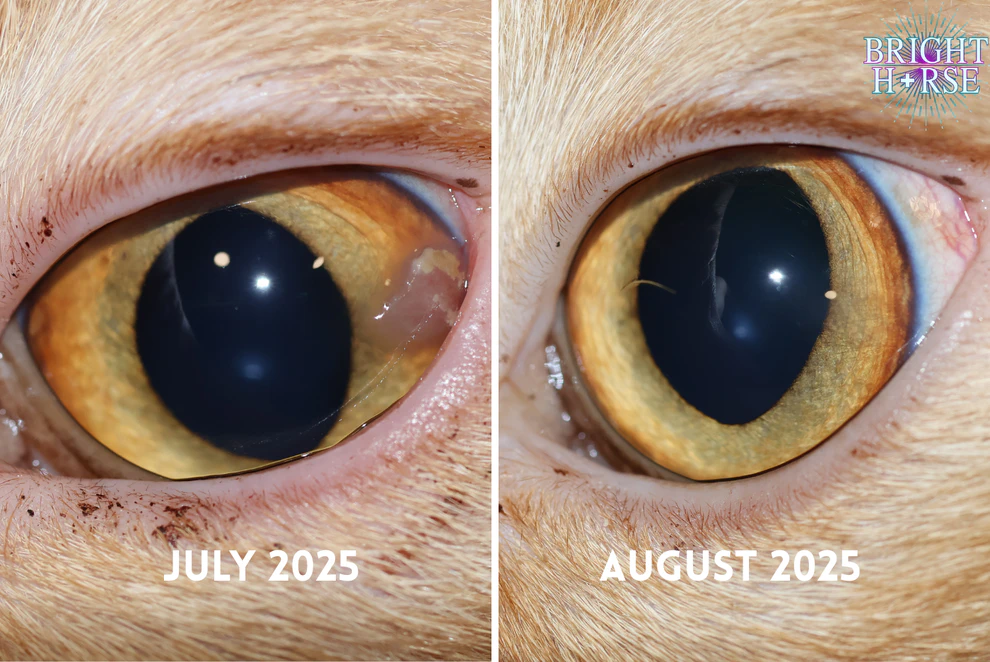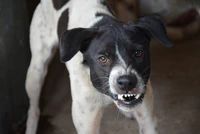When It’s Not Just Behaviour: Django’s Story
There’s a moment every one dreads, those who care for our animals, when we’ve done everything right, followed every piece of advice, and the behaviour still isn’t improving. You change the environment, you work on training, you’ve given them time, patience, and love… and yet, nothing changes.
It’s frustrating, so frustrating… It’s exhausting and you just want to give up. And if you’re anything like me, it’s also a little heartbreaking, as you feel like YOU failed them.
As a behaviourist, I know that when progress stalls, there’s usually a reason and often, it’s not the animal “being stubborn” or “just their personality.” Sometimes, it’s because something deeper is going on, hidden beneath the behaviour.
This is the story of my cat Django, and how I learned (again) that the key to solving a behaviour problem can be found in the most unexpected place. Whether you are a horse, dog or cat owner, this story applies to us all.
Meet Django (and His Brother)
Django came to us as a rescue kitten, along with his brother, Cache in August 2024. Same litter, same start in life but they couldn’t have been more different in behaviour.
From day one, Django was at little more anxious and on edge. He’d bolt from the room if we moved too quickly, avoided touch, and seemed permanently on guard. His brother, on the other hand, was a loveable menace into everything, climbing on everyone, and generally convinced the world was his playground.
Living with the two of them side by side made it impossible to write Django’s behaviour off as “just a shy cat.” The difference was too stark, it was beyond just settling in.
Something about his behaviour felt… was off to me. And I couldn’t shake the feeling that there was more to the story beyond behaviour and training.
Early Red Flags
It wasn’t long before Django’s behaviour started to raise more serious concerns by Christmas 2024, dispite my attempts to support his behaviour through behavioural modfication. He began peeing indoors, always choosing soft items like bedding or clothes, horse rugs and my work bag… and it was completely unpredictable. He was jumpy around us if we moved to quickly, terrified of strangers (when we had visitors, unlike the other members of our gang who were delighted to meet new friends), and he would quickly bolt from any sudden movement or noise. A Red flag.
Physical affection wasn’t just unwelcome for him, it seemed to make him more stressed/uncomfortable. He would only go to my husband, at set times 10am-11am, and need/suckle my husbands arm. Now, this might seem cute but it is also a selfsoothing behaviour that after weaning a cat should no longer perform. Another Red flag for me.
These weren’t the kind of ‘quirks’ that settle down with time or gentle socialisation, he wasn’t going to grow out of it, the behaviours I was seeing were telling me something (I just didn’t know what! To my endless frustration).
I’d already started putting behavioural strategies in place, they worked for a while but nothing seemed to stick. This is yet another a red flag for me, learning and training is not the issue, there is something else at play. It was as if something invisible was keeping him in a constant state of tension.
The First Investigations
My first step, from August to Christmas, was to treat it like any other behaviour case start with the basics and work systematically. I made sure Django’s environment was set up to support him, his cat needs and reduce stress wherever possible.
We added multiple litter trays (five), all very large and filled deep because cats like plenty of space to toilet comfortably. Cat’s generally aren’t a fan of litter trays, but keeping them big (so they have plenty of space to move), plus a deep litter (so they can dig) and also emptying it reguarly. All help.
Even though they’re indoor cats, I do supervised outdoor time in the back garden, training them to stay within the boundaries. Adding enrichement and supporting nature behaviours for my gang. Monte (Cat), Izzy (Dog), and his brother Cache (Kitten) all enjoyed exploring outside, enrichement toys, chasing flies, smells and going toilet outside. I do enrichement with them outside and play.
But Django was too frightened to engage… running back into the house scared. He was too scared to explore or even do fun enrichement work. Training sessions with recall and treats worked well for the others, but Django simply couldn’t participate.
I also created more safe spaces inside. We put tunnels in the hallways, so no cat ever felt “chased” down a landing or corridor (as it is a narrow space), we added climbing frames and high perches in multiple rooms, and even ran climbing routes up the banister. There were beds and resting spots scattered throughout the house so he always had somewhere secure to retreat to.
Put it this way, my house is a cat playground on steriods!
Because touch made him anxious, I didn’t push physical affection, as much and all as I would love to cuddle him… he said ’no’. So Instead, I focused on playing with him (which he loved), using lick mats, and offering enrichment that didn’t involve handling. All helped build a relationship between us.
Even with all these adjustments, the changes were minimal. That’s when I moved on to a six-week gabapentin trial (Jan - Feb 2025), as I thought pain might be a factor and this medication has a secoundary anti-anxiety affect. But again, I saw no significant improvement. From there, I went all in on the veterinary side the full works!
Django had a full days work-up: mutiple x-rays, blood tests, urine tests, eye and teeth, the lot. Everything came back clear.
On paper, he was a healthy young cat. In reality, his behaviour told a different story. And I was stil convinced that we just hadn’t found it yet.
The Rule of Thumb That Guides Me
Over the years, I’ve learned a simple way to help decide whether I’m dealing with a primarily behavioural issue or whether something medical might be in play.
If behaviour training changes around 80% of the problem, it’s probably behavioural. If it only changes 20%, it’s probably medical.
‘The 80/20 rule, also known as the Pareto principle, states that roughly 80% of effects come from 20% of causes. In simpler terms, a small portion of inputs often accounts for the majority of outputs.’
With Django, despite all the environmental changes, enrichment, and careful behaviour work (from Aug, to Christmas), we were barely hitting that 20% mark. That told me something important training alone wasn’t going to fix this. There was an underlying issue we hadn’t found yet, and until we did, his behaviour & quality of life was unlikely to improve in any meaningful way.
My Rule of Rule of Thumb, 80/20 or Pareto principle. When we can measure it, we are better at doing something to support it.
It goes like this:
- If behaviour training changes around 80% of the problem, we’re probably looking at a primarily behavioural issue. The animal’s environment, learning history, and emotional associations are the main drivers, and training can address them effectively.
- If behaviour training only changes around 20% of the problem, it’s a red flag for me that something medical might be contributing pain, illness, sensory changes, or another physiological factor that’s limiting progress.
This idea comes from a blend of practical experience and behavioural science. In learning theory, behaviour is influenced by three key factors:
- Antecedents – what happens before the behaviour
- Consequences – what happens after the behaviour
- The organism’s current state, the animal’s physical and emotional condition
We can train and adjust the first two as much as we like, but if the third factor the animal’s physical state is compromised, it acts like a weight dragging down progress. Pain, discomfort, or illness changes how an animal perceives and responds to the world. It affects motivation, tolerance, and even the ability to learn.
With Django, we were firmly in that 20% territory. Despite all the enrichment, environmental changes, and targeted training, the improvements were tiny. That told me loud and clear: the behaviour wasn’t the root problem it was a symptom. Until I found and treated the cause, no amount of behaviour work was going to make the real difference.
The Breakthrough Moment
The turning point came when I went away for a week. Sometimes, when you’re living with a problem day in and day out, you stop seeing the smaller details. That little bit of distance meant that when I came home, I noticed something I’d missed before a tiny ulcer on Django’s eye.
It was subtle, but it didn’t look right. I knew eye pain in cats can be excruciating, and that even small ulcers can have a big impact on behaviour. The next challenge was finding someone who could properly assess it. Easier said than done there are only two veterinary ophthalmologists in the whole of Ireland, thank goodness for Primrose Hill Veterinary Hospital
That appointment changed everything. We finally had the missing piece of the puzzle.
The Diagnosis
The specialist confirmed what I’d suspected the ulcer wasn’t the full story, it was a symptom. Django had an autoimmune condition, most likely linked to feline herpes virus, which is incredibly common in the cat population. Even though his blood tests came back negative for feline herpes virus, all signs pointed towards it. In his case, stress and anxiety were triggering flare-ups of the autoimmune condition, creating an ulcer, and those flare-ups were causing painful inflammation and damage to his eye. Creating more pain, and more stress. A horrible cycle.
This wasn’t just uncomfortable it was very painful. And when you think about it, the behaviour changes made perfect sense.
Pain can make even the friendliest animal withdraw, avoid contact, and become hyper-alert to anything that might make the discomfort worse, act oddly. In Django’s world, the safest option had become avoiding touch, avoiding people, and finding places where no one could reach him.
The diagnosis didn’t just give us a name for what was happening it gave us a clear direction for how to help him.
The Treatment and Transformation
We started Django on a course of steroid eye drops to treat the inflammation, alongside antiviral drops and fluoxetine (cat anti-anxiety meds) to help lower his baseline anxiety and reduce stress-triggered flare-ups. The aim was simple, relieve the pain, reduce the stress, and give him the space to feel safe again. Then my behavioural work would actually work.
Within weeks, the change was undeniable. The painful squint was gone. He started moving through the house with confidence, choosing to be in the same room as us instead of hiding, looking for cuddles, play and engaging with us. The indoor peeing stopped entirely.
He began engaging in play more often, and even sought out affection on his own terms. I even got to start training him, and play outside! Where he was previously terrified of the backgarden, he was running about playing with his brother and enjoying enrichment.
For the first time since we’d brought him home, Django looked comfortable in his own skin. And with the pain gone, that anxious, guarded cat was replaced by one who was just as cheeky and bold as his brother, Cache.
Life Now
These days, Django is a completely different cat. He struts around the house with confidence (he is very handsome and knows it), plays chase with Cache, and happily sprawls out in the middle of the living room without a hint of tension in his body. He’s curious, cheeky, jumps on the counter looking for cheese when I cook! And far more willing to engage with us not just for food, but because he wants to be part of what’s going on.
Watching him race up the banister climbing frame to bat me on the head or playfully bat at Monte’s tail is a daily reminder of just how much pain can shape behaviour, and how different an animal can be once that pain is gone.
Takeaways for All Animal Owners
Django’s story isn’t just for cat owners it’s an important lesson for anyone who shares their life with an animal, whether that’s a dog, a horse, or cat. Across the board, we’re all living, breathing mammals with the same basic biology. Pain, illness, and discomfort affect us all in similar ways, and for animals, behaviour is often the only way they can communicate that something isn’t right.
Here are the key lessons I take from his journey:
- Sudden regression is a red flag. Animals don’t go from confident to withdrawn without a reason.
- Pain changes behaviour. Even subtle, chronic pain can make an animal more fearful, reactive, or avoidant. Behaviour is a symptom and we need to listen.
- Behaviour and medicine work together. The most successful outcomes happen when vets and behaviourists collaborate.
- The 80/20 helps us measure outcomes. If training only shifts the problem by 20%, investigate medical causes.
No step is wasted. Every environmental change, training attempt, or medical test builds a clearer picture of what’s going on.
The most important thing? Keep asking questions. Your persistence might be the very thing that changes your animal’s life no matter the species.
Closing Thoughts
This case is deeply personal for me, I work in behavioural science every day, supporting clients with animals whose behaviour often has clinical or medical roots. I take many cases home with me, and I know, professionally, that it can take time to get to the real cause but living it with my own animal was another thing entirely.
There were so many moments when I felt like giving up. And it wasn’t just me in it my husband, who adores our cats, was right there too. We were both desperate to make Django’s life better. We invested in veterinary diagnostics x-rays, bloodwork, full work-ups and while some results came back clear, I don’t see any of it as wasted money. Those “normal” results ruled things out and guided us towards the right answer.
The ulcer on his eye was incredibly painful, yet the treatment was simple once we found it steroid drops and anti-anxiety medication. Now he’s living his best life, pain-free, confident, and comfortable.
This whole journey has reinforced one of the biggest truths I know:
It doesn’t matter how much training you do, sometimes training isn’t the solution. Sometimes, it’s medical. And when we find that piece, that’s when everything changes.




